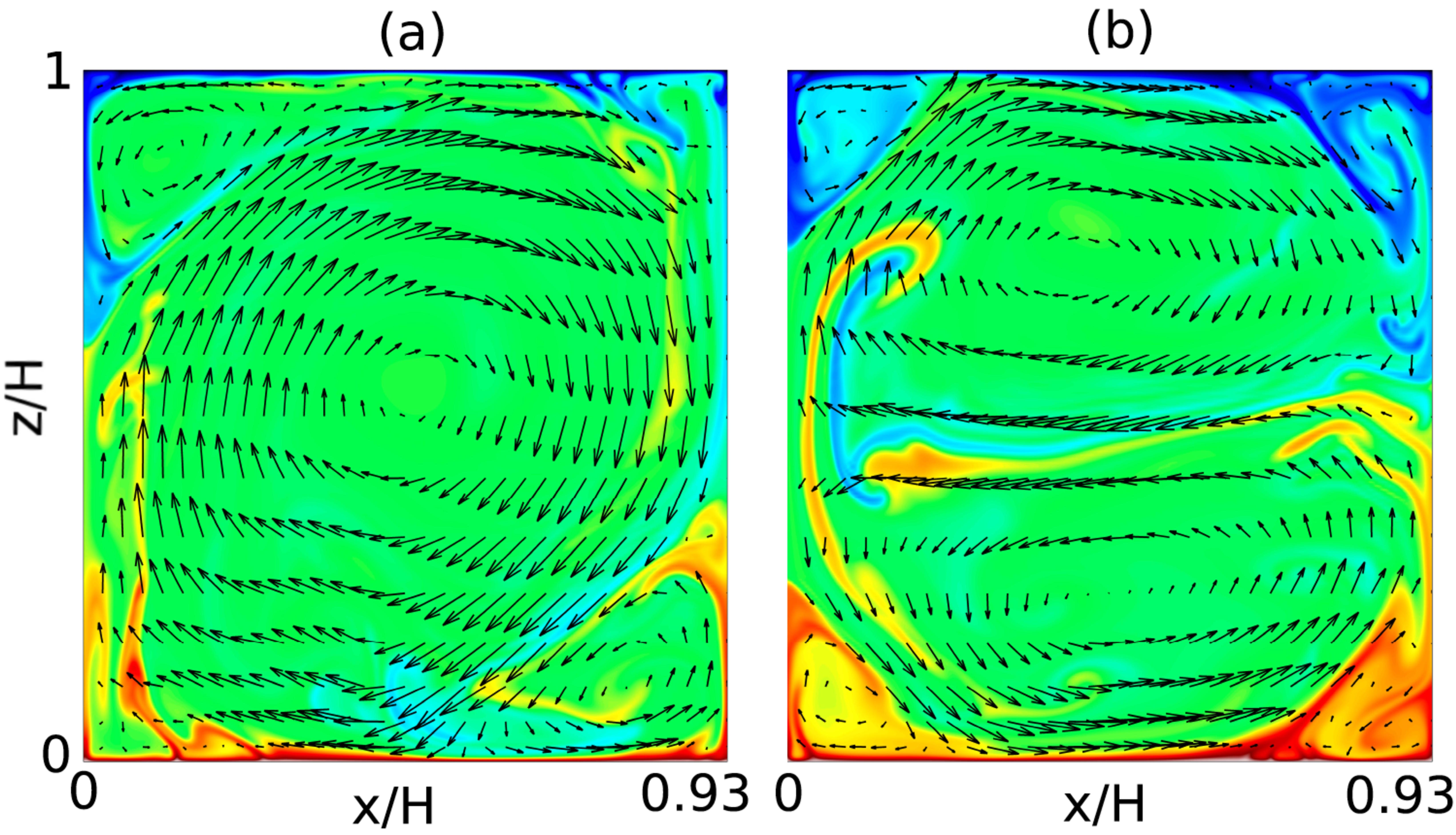2D Rayleigh-Bénard convection
One of the most striking features of Rayleigh-Bénard flow is the emergence of a large scale convection roll. This roll is driven by small scale thermal plumes detaching from the thermal boundary layers at the top and bottom. Remarkably, under certain conditions the large scale convection roll can reverse its direction. For example for Γ= 1, Pr = 4.3 (typical for warm water), and Ra = 108 spontaneous reversals of the large scale convection roll occur (see figure 1 and Sugiyama et al., Phys. Rev. Lett. 105, 034503 (2010)), whereas for slightly larger Ra = 5x108 or for slightly smaller Pr = 0.7 (typical for gas) these reversals are suppressed. We found that the corner flows, which establish themselves next to the large scale convection roll (see figure 1), play a central role: They are fed by the detaching thermal plumes, but also loose energy towards the large scale roll. Once the feeding process overwhelms the heat leakage the corner flows can build up and eventually take over, leading to a reversal of the large scale wind [1]. For a press release about this work see FOM press release (in Dutch).

FIG. 1. Top panel: Snapshots of the temperature (color) and velocity (arrows) field and time trace of angular momentum from numerical simulations (Ra=108 and Pr = 4.3). Bottom panel: Snapshots of the velocity field and time trace of angular momentum from experiment (Ra=3.8x108 and Pr=5.7). (a), (b), and (c) show the instantaneous dimensionless temperature (T-Tt)=Δ distribution. (d) shows the temporal change of the dimensionless angular momentum L(t)=L0, where L0 is the maximum of the absolute value of L. The positive and negative signs indicate the anti-clockwise and clockwise circulations, respectively. (e), (f), and (g) show the PIV-measured instantaneous velocity field and (h) the normalized instantaneous angular momentum L(t)=L0. The color bar indicates the magnitude of the velocity (in unit of cm/sec). The snapshots in (a), (b), and (c) give numerical, and those in (e), (f), and (g) give experimental examples of the large scale circulation before, during and after a reversal process, as indicated in (d) and (h) respectively. Note that (b) and (f) show clearly the key role played by the growth of the corner rolls in the reversal process. Figure taken from Sugiyama et al., Phys. Rev. Lett. 105, 034503 (2010).
In subsequent research [3] [4] we studied the aspect ratio (Γ) dependence of the heat transfer (Nusselt number Nu in dimensionless form) in turbulent two-dimensional Rayleigh-Bénard convection for different Rayleigh and Prandtl. We found that Nu(Γ) shows a very rich structure with sudden jumps and sharp transitions. We connect these structures to the way the flow organizes itself in the sample, see figure 2 and the corresponding movie link in the figure caption. We find that even for fixed control parameters different turbulent states (with different resulting Nu) can exist, between which the flow can or cannot switch. In the latter case the heat transfer thus depends on the initial conditions. This has implications for the comparison between two- and three-dimensional Rayleigh-Bénard convection as is discussed in Ref. [5].

FIG. 2. Two temperature snapshots for Ra = 109, Pr=4.3, and Γ=0.93. The system is either in the single roll state (a) or in the double roll state (b). Figure taken from Ref. [3]. A movie of the transition process can be watched here and is published in the supplementary material of van der Poel, Stevens, and Lohse, Phys. Rev. E 84, 045303(R) (2011) where more movies can be found.
References
-
X. Zhu, V. Mathai, R.J.A.M. Stevens, R. Verzicco, and D. Lohse,
Transition to the ultimate regime in two-dimensional Rayleigh-Bénard convection,
Phys. Rev. Lett. 120, 144502
Selected for the cover illustration. -
X. Zhu, R.J.A.M. Stevens, R. Verzicco, D. Lohse,
Roughness-facilitated local 1/2 scaling does not imply the onset of the ultimate regime of thermal convection,
Phys. Rev. Lett. 119, 154501 (2017) -
E.P. van der Poel, R.J.A.M. Stevens, D. Lohse,
Comparison between two and three dimensional Rayleigh-Bénard convection,
J. Fluid Mech. 736, 177-194 (2013). -
E.P. van der Poel, R.J.A.M. Stevens, K. Sugiyama, D. Lohse,
Flow states in two-dimensional Rayleigh-Bénard convection as a function of aspect-ratio and Rayleigh number,
Phys. Fluids 24, 085104 (2012). -
E.P. van der Poel, R.J.A.M. Stevens, D. Lohse,
Connecting flow structures and heat flux in turbulent Rayleigh-Bénard convection,
Phys. Rev. E 84, 045303(R) (2011). -
Q. Zhou, K. Sugiyama, R.J.A.M. Stevens, S. Grossmann, D. Lohse, K.-Q. Xia,
Horizontal structures of velocity and temperature boundary layers in 2D numerical turbulent Rayleigh-Bénard convection,
Phys. Fluids 23, 125104 (2011).
-
K. Sugiyama, R. Ni, R.J.A.M. Stevens, T.S. Chan, S.-Q. Zhou, H.-D Xi, C. Sun, S. Grossmann, K.-Q. Xia, D. Lohse,
Flow reversals in thermally driven turbulence,
Phys. Rev. Lett. 105, 034503 (2010),
Featured in the FOM News (in Dutch), 19 July 2010